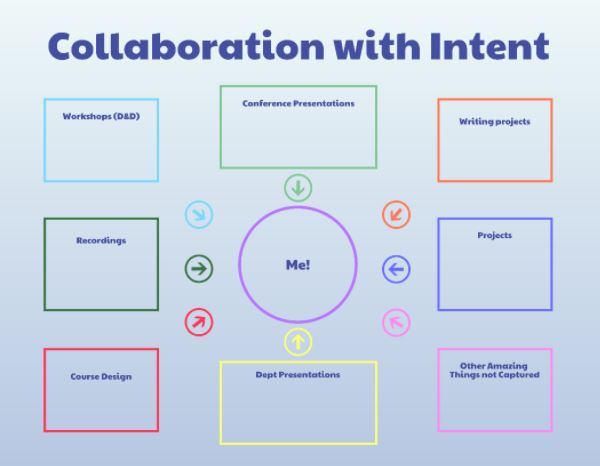Time to Better Understand Collaboration
While higher education is defined by debate and discussion, it would not be difficult to find a consensus that collaboration is an essential component of any learning. Tremendous support for this position came from the switch to emergency remote delivery, when it became clear that time-proven methodologies of class delivery were not transferable to the digital realm. What once seemed so easy to facilitate by shared space and physical placement became a screen of turned-off cameras, digital echoes, interruptions, and, perhaps worst of all – the dead silence of the void.
While undoubtedly difficult, KPU faculty rose to the challenge, and bravely explored new software tools and environments and creatively adapted their experience. In the process, many discussions were had, and much experimentation was done concerning what exactly ‘collaboration’ means for specific tasks and assignments. Direct replication of many grouping strategies in digital spaces was not always effective and new strategies were needed.
The need for innovative approaches also motivated instructors to explore new pedagogical frameworks as a means of better developing their skills to use technology effectively. One simplistic structure was to explore curriculum delivery by focusing on time, more specifically, the time the class needs to be together to learn, and when they do not. This is one reason why the terms, synchronous (at the same time) and asynchronous (not at the same time) have become so prevalent in educational literature.
While Blended and Hybrid models focus on face-to-face versus online, the division into time allows for “theblending of both asynchronous and synchronous online learning, where students can participate in anytime, anywhere learning during the asynchronous parts of the course but then participate in real-time activities for the synchronous sessions,” (Martin, 2021). It is especially useful for collaboration and allows the instructor to better define how it should happen over the length of the course.
This focus on time is also incredibly useful to promote reflection and renegotiation of past methodologies as we prepare for a homecoming to shared physical space. Instead of a wholesale return to making furniture placement and/or different rooms per group as the core of collaborative preparation, it might be better to focus on how collaboration should occur over time. This may occur from instructors matching their pedagogical need to a facilitating software tool, or digital or physical environment; or a mix of both. This simple framework of time illuminates whether students need to be together at the same time to perform tasks as a whole, or as part of a larger process, ie. group projects. Knowing more clearly what should be done by students, and why it is supporting learning outcomes, instructors can peruse KPU’s technology offerings with more confidence that their choices will empower student learning.
In terms of online, synchronous interaction, KPU provides BigBlueButton (BBB) and Zoom for teaching, and Microsoft Teams for administrative tasks, like office hours. As is well detailed in our Conferencing tools for teaching and learning: Best practices Pressbook, BBB is designed to mimic more of a classroom environment and is great for promoting synchronous participation with features such as chat, and shared notes, enhanced polling, and a ‘raise hand’ button. BigBlueButton’s entire design is clearly influenced by a classroom aesthetic. Zoom, in contrast, is much simpler in its design and more Spartan in its layout. There is only the chat area and the Emojis for choosing features, like ‘raise hand’, are more simply nested than BBB. As such, promoting collaboration in a lesson that might be heavy on content and need multiple interactions, BBB might be the better choice to better handle the academic needs of the class. However, simpler, perhaps more discussion-based collaboration might be better in Zoom since the simplicity of its layout matches the simple needs of the lesson.
The administrative backbone of KPU’s online learning, Moodle LMS, has tools which can further facilitate synchronous and asynchronous collaboration, but not at the same intensity as putting partners in a breakout room ‘face-to-face’. The chat tool in Moodle is an excellent choice for synchronous discussions on topics, and simply need a set time for students to log in together. With the recent upgrade to Moodle 3.9, all this chat can be responded to and assessed with a great variety of privacy and individuality. For example, a teacher can comment directly to one student about one of their remarks or use the chat as part of grading.
Moodle forums on the other hand, are useful to promote asynchronous collaboration. Perhaps you want to use student postings of opinions on class content to introduce the next material. With that type of pedagogical need, time for contemplation, response and reformulation must be included, and thus ‘at-the-same-time’ activities would not provide as rich of an educational experience. Collaboration is fundamental to the learning outcomes but when students need to be doing this can directly impact the ‘how’ of that delivery.
Other tools, like the database and Wiki tools are excellent asynchronous tools for collaboration when a project demands that learners engage with large amounts of content that will be accumulated. As such, these types of projects often need a synchronous element, as well. For example, if a group is assigned to develop a Wiki on a specific course topic, the instructor may assign a Moodle chat so students can meet to plan or may even have a video conferencing session to start the discussion, and a Moodle chat or forum assigned for ongoing communication. Another tool for projects requiring accumulation of content over a term or semester is the Moodle glossary. The glossary allows for the collaborative building of shared vocabulary or content, with contributions from individuals or groups.
While we do want to give guidance on utilizing KPU tools and environments, it is likely impossible to give a definitive list of which can be used for collaboration. It really does depend on the pedagogical need and the style of the instructor. OneDrive is perhaps the most important collaborative tool as it is where media and content can be stored and manipulated in a secure, private environment, but many see it as a passive storage area.
It is time (pun intended) to apply what we have learned from our pandemic travails and approach the planning of collaboration as a multi-faceted ingredient to learning that can be more helpfully understood through a framework of time. When we do, it will benefit students, instructors and result in the development of more innovative higher education.
Martin, F. (2021, March 25). What is Bichronous online learning? HPT Treasures – for Evidence Based Performance Improvement.https://hpttreasures.wordpress.com/2021/03/25/what-is-bichronous-online-learning/




